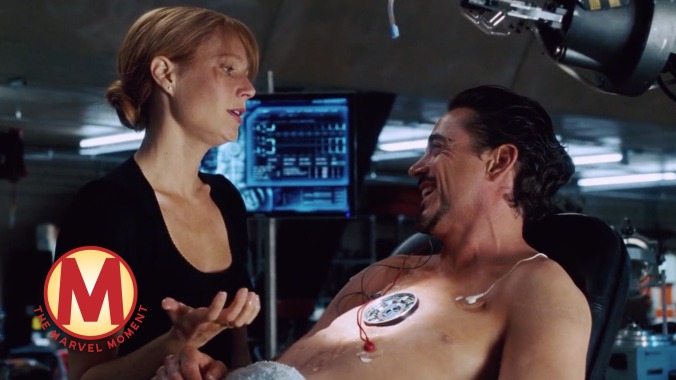Iron Man opens his heart, setting the screwball stage for the whole Marvel Cinematic Universe
Image: Screenshot: Iron Man

It’s hard to envision what the Marvel Cinematic Universe would look like today if it hadn’t kicked off with Iron Man. Would it exist at all? A different movie, one built on a different character and/or approach, might not have connected with audiences in the same way—and if the test balloon popped, the whole plan to build an interconnected blockbuster franchise around second-string superheroes might have deflated with it. Iron Man, of course, was a giant hit, and as such became the template for everything that came after it. In other words, a series that’s about to reach its 22nd installment is still working off the foundation laid down by unlikely event-movie maestro Jon Favreau and his team of screenwriters, who had the fairly novel idea to foreground the alter-ego side of the superhero equation—to pay more attention to the man than the iron.
There are, to be clear, plenty of action scenes in Iron Man, from Tony Stark’s emergence from that cave in his first, golem-like stab at a super suit to the mano-a-mano climax, which set an unfortunate precedent for the way these movies often end, with CGI figures slugging each other. Favreau’s coup, though, was making all that bang and clang feel secondary. Bucking the conventional wisdom that origin stories are the drag you endure to get to the explosive “good stuff,” he treats the character beats leading up to the pyrotechnics like the good stuff—a strategy that works mostly because of Robert Downey Jr., delivering the sardonic, charismatic, complicated star performance on which this movie and whole cinematic universe rests. When Stark drops his closing press-conference bombshell (a scene we considered highlighting here), the moment rings with dual meaning. The suit is a special effect. Downey is Iron Man.
To that end, none of the big set-pieces, cutting from a digital avatar jetting around to the actor’s face tightly framed “inside” the hardware, really speak to Iron Man’s influential appeal. Much more exemplary is the scene below. Thanks to a loose copper wire, Downey’s Stark has to replace the electromagnet in his chest cavity—the handmade device keeping loose pieces of shrapnel from piercing his heart—with a new model. But he can’t do it himself; he needs his personal assistant and budding love interest, Pepper Potts (Gwyneth Paltrow), to manually yank the old one out. This game of Operation, as Stark calls it, does not go as smoothly as planned.
It’s an inspired midfilm pocket of suspense and screwball comedy, powered by the tension between Downey’s cucumber cool and the escalating danger of his predicament. A lot of the scene’s snap comes from the His Girl Friday chemistry shared by the two stars, who deftly shift the dynamic over its few minutes, so that it’s her suddenly reassuring him halfway through. (Their dialogue is priceless, and possibly improvised—the movie, after all, went into production without a finished script, which made the suits at Marvel very nervous.) In this moment, the film also finds a pretty fun, nifty way to illustrate its character arc: In becoming Iron Man, and in scrapping his company’s unethical business model, Stark is figuratively rebooting himself. He’s also figuratively and literally opening his heart to someone he’s only just beginning to realize he loves—a confirmed bachelor and egomaniac learning to be vulnerable.
In a sense, we’re seeing the whole glowing core of the Marvel Cinematic Universe lock into place. The series, like this scene, would continue to highlight personalities, relationships, and performances. It would also continue to push humor to the forefront; in a sense, Downey’s mixture of urgency and irreverence, on full display here, would become the franchise’s driving sensibility. Maybe there’s a metaphor, too, in the scene’s gross-funny central image. With Iron Man, what was Marvel doing but yanking out the old version of a superhero spectacular—a risky procedure, that—and replacing it with something shiny and new?